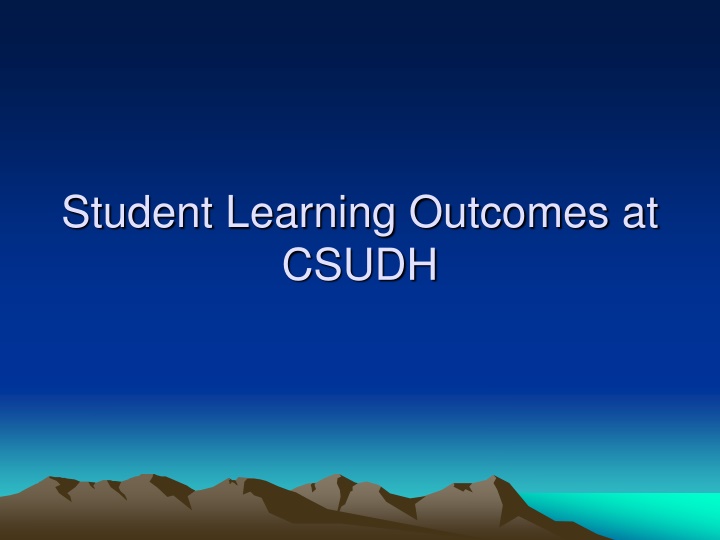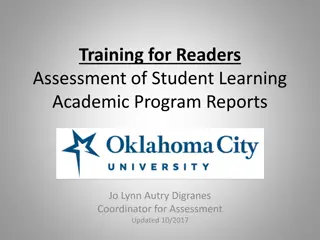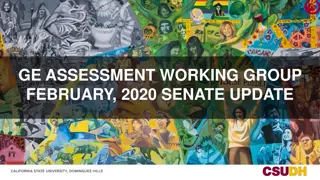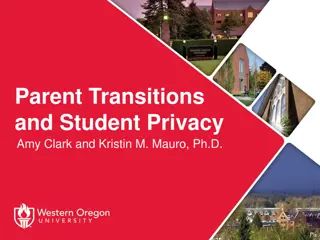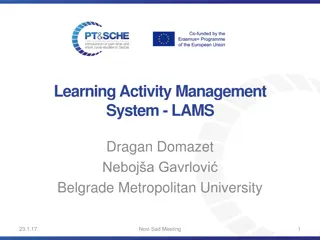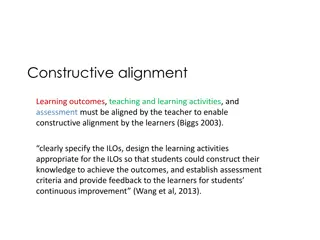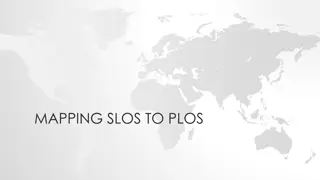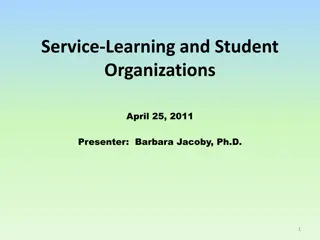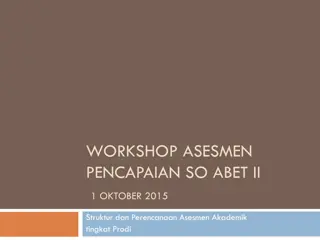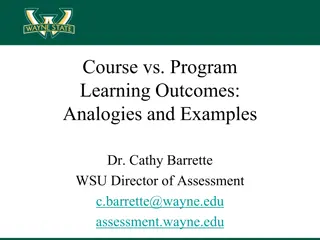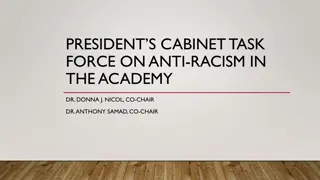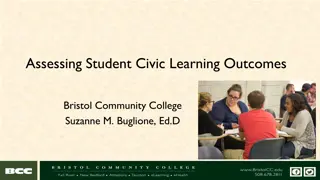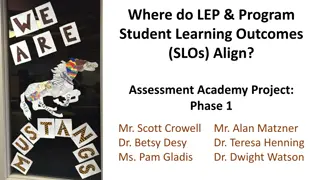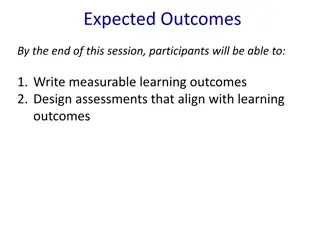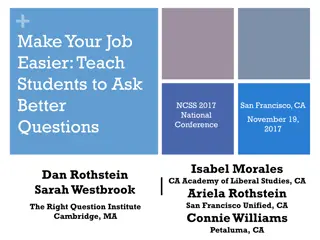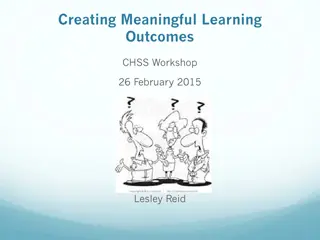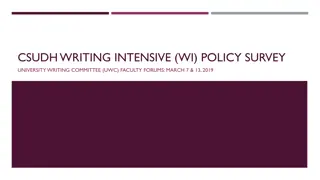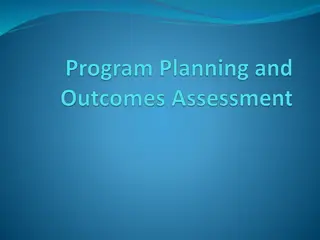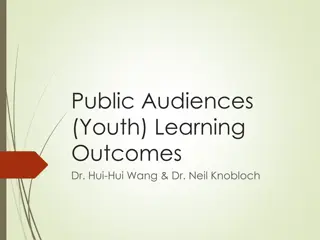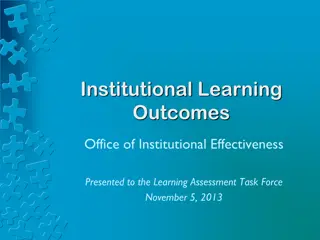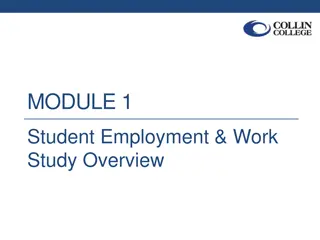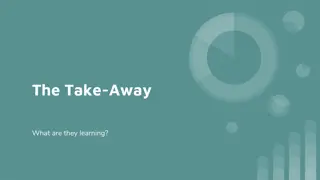Student Learning Outcomes at CSUDH
Outcomes assessment is crucial to ensure students are learning as expected. Student Learning Outcomes at CSUDH must be measurable and encompass cognitive knowledge, skills, and values. Examples include critical thinking, communication, information literacy, disciplinary proficiency, and engaged citizenry. Graduate level learning outcomes also play a significant role in evaluating student progress. Understanding how to get started with setting outcomes, linking program-level outcomes, and mapping the curriculum are essential steps in this process."
Download Presentation

Please find below an Image/Link to download the presentation.
The content on the website is provided AS IS for your information and personal use only. It may not be sold, licensed, or shared on other websites without obtaining consent from the author.If you encounter any issues during the download, it is possible that the publisher has removed the file from their server.
You are allowed to download the files provided on this website for personal or commercial use, subject to the condition that they are used lawfully. All files are the property of their respective owners.
The content on the website is provided AS IS for your information and personal use only. It may not be sold, licensed, or shared on other websites without obtaining consent from the author.
E N D
Presentation Transcript
Outcomes assessment can tell us if our students are really learning what we think they should be able to do.
Student Learning Outcomes: Are the cognitive knowledge, behavioral skills and/or affective values you expect your students to achieve. Must be stated in measurable terms. Are faculty-generated.
SLO Examples (our ILOs) Think critically and creatively and apply qualitative and quantitative reasoning to address complex challenges and everyday problems locally and globally. (Critical Thinking) Communicate clearly and collaborate effectively in a range of social, academic, and professional contexts, both orally and in writing. (Communication) Locate, evaluate, and effectively use information in pursuit of discovery as preparation for continuous lifelong learning. (Information Literacy) Demonstrate expertise in a specialized discipline of study and the ability to integrate its ideas, methods, theory and practice. (Disciplinary Proficiency) Develop knowledge of diversity and multicultural competencies and ways to use that knowledge to promote equity and justice at local and global levels. (Engaged Citizenry)
Graduate Level Learning Outcomes
How to get started The first step in the process is for the departmental faculty to meet and decide on the outcomes. There usually should be between 5-10 of these. For accredited programs, many of the outcomes will already be specified. Produce a curriculum map to see how these are covered in the curriculum.
I = concept introduced; R = concept reinforced; F = final assessment Outcome Number 1 2 3 4 5 6 7 101 120 122 161 223 245 266 313 325 345 355 362 375 380 421 435 446 453 455 490 I I I I R I R R R R R R R R R R R R R R R R R R R R R R R R R R R F R R R F F F
The program-level outcomes should link with both the Institutional Learning Outcomes and with course-level outcomes.
Not every outcome need link to the ILOs, but every program should have at least a few connections.
Course-level outcomes These should be stated in the Student Learning Outcomes. The link between the Program-level outcomes and the Course-level outcomes can be put into a table.
The program should also choose its assessment tools.
Indirect assessments Surveys of students, graduates, and employers Exit interviews Focus groups
Direct assessments Scoring Rubrics: can be used to holistically score any product or performance such as essays, portfolios, recitals, oral exams, research reports, etc Capstone Courses Case Studies Embedded Questions to Assignments Standardized Achievement Tests Locally developed exams with objective questions Locally developed essay questions Reflective Essays Collective Portfolios
Although both indirect and direct measures can be used to assess student learning, direct measures yield better, more reliable data.
The program needs also to decide what level of achievement of each of the outcomes is acceptable.
Criteria for Success Set criteria for each PLO Basic % students to achieve minimum requirements Intermediate % students to achieve above average level Advanced % students to achieve expert level
Then start assessing! Create a schedule for assessing the outcomes. Collect the data and analyze it. See if the students have achieved the preset goals. If they have, then continue assessing on a regular schedule to make sure they keep making the goals.
If the students are not achieving the goals: The program should meet to decide on a course of action to correct the problem. If curricular changes are required, these should be initiated and completed.
Closing the Loop Did the changes improve outcomes? If not, work out a solution. If successful, continue regular assessment.
For links to rubrics, syllabus construction, and forms: http://www.csudh.edu/academic -affairs/student- learning/resources/index
USLOAC members are available for one-on-one help Email lcarrier@csudh.edu
Mission CSUDH Strategic Framework We provide education, scholarship and service that are, by design, accessible and transformative. We welcome students who seek academic achievement, personal fulfillment, and preparation for the work of today and tomorrow. Vision By 2015, we are known as a gathering place where: Diversity in all its forms is explored, understood, and transformed into knowledge and practice that benefit the world. Our use of technology allows us to transcend our boundaries as we reach out to students, both locally and globally. Sustainable environmental, social, and economic practices are a way of life. Our educational partnerships ensure pathways and support for local students to aspire to and complete a college degree. We are engaged in serving the dynamic needs of the surrounding communities. Student life is meaningful and vibrant. Our accomplishments and those of our alumni are recognized nationally and internationally. As a result, our students graduate with an exemplary academic education and a genuine commitment to justice and social responsibility. Core Values Collaboration among all segments of the campus community Continuous Learning that improves teaching, scholarship, and service Rigorous Standards of excellence in all our practices. Proactive Partnerships with our communities Respect for diversity in all forms Responsiveness to the needs of students and society
